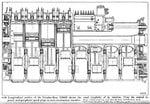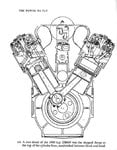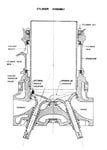It is historic fact that Damlier Benz worked on a 16 cylinder development of the DB603 line of engines under the DB609 type number. Development of this engine was abandonned in April of 1943.
From what little I have been able to find out, it was a conventional V16 design with a crankshaft that was 8 throws long, and the propeller reduction gear at the end of the engine. My guess is that torsional vibration and twisting of such a long heavily loaded carnkshaft was a major difficultly, and that correcting crankshaft problems was beyond the ability of the Damlier Benz engineers and technicians.
But what if DB had built the engine like the Chrysler IV-2220?? Use the pistons, rods, valves, etc. from a DB603 to build a 162 mm bore x 180 mm stroke sixteen cylinder engine as essentually two V-8s end to end with the propeller reduction gears in the center of the engine. Now there are two short stiff crankshaft segments, and a the two crank segments could have been isolated from each other with a vibration damper or quill shaft. I estimate that the weight of such an engine with a single stage supercharger would have been around 2700 pounds (1230 kg).
This likely would have given the German airforce a reliable alternate to the Jumo 222 on a timely basis. Maybe this could have been the 2500 HP engine that they needed for later versions of the He 219, Ju 388, etc. and the Bomber B projects.
That is all I think i know.
Piper106
From what little I have been able to find out, it was a conventional V16 design with a crankshaft that was 8 throws long, and the propeller reduction gear at the end of the engine. My guess is that torsional vibration and twisting of such a long heavily loaded carnkshaft was a major difficultly, and that correcting crankshaft problems was beyond the ability of the Damlier Benz engineers and technicians.
But what if DB had built the engine like the Chrysler IV-2220?? Use the pistons, rods, valves, etc. from a DB603 to build a 162 mm bore x 180 mm stroke sixteen cylinder engine as essentually two V-8s end to end with the propeller reduction gears in the center of the engine. Now there are two short stiff crankshaft segments, and a the two crank segments could have been isolated from each other with a vibration damper or quill shaft. I estimate that the weight of such an engine with a single stage supercharger would have been around 2700 pounds (1230 kg).
This likely would have given the German airforce a reliable alternate to the Jumo 222 on a timely basis. Maybe this could have been the 2500 HP engine that they needed for later versions of the He 219, Ju 388, etc. and the Bomber B projects.
That is all I think i know.
Piper106



